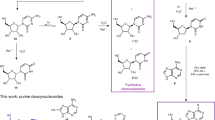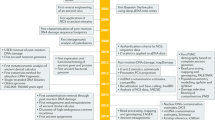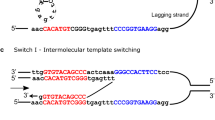Abstract
In the absence of repair, lesions accumulate in DNA. Thus, DNA persisting in specimens of paleontological, archaeological or forensic interest is inevitably damaged1. We describe a strategy for the recovery of genetic information from damaged DNA. By molecular breeding2 of polymerase genes from the genus Thermus (Taq (Thermus aquaticus), Tth (Thermus thermophilus) and Tfl (Thermus flavus)) and compartmentalized self-replication3,4 selection, we have evolved polymerases that can extend single, double and even quadruple mismatches, process non-canonical primer-template duplexes and bypass lesions found in ancient DNA, such as hydantoins and abasic sites. Applied to the PCR amplification of 47,000–60,000-year-old cave bear DNA, these outperformed Taq DNA polymerase by up to 150% and yielded amplification products at sample dilutions at which Taq did not. Our results demonstrate that engineered polymerases can expand the recovery of genetic information from Pleistocene specimens and may benefit genetic analysis in paleontology, archeology and forensic medicine.
This is a preview of subscription content, access via your institution
Access options
Subscribe to this journal
Receive 12 print issues and online access
$209.00 per year
only $17.42 per issue
Buy this article
- Purchase on Springer Link
- Instant access to full article PDF
Prices may be subject to local taxes which are calculated during checkout



Similar content being viewed by others
References
Pääbo, S. et al. Genetic analyses from ancient DNA. Annu. Rev. Genet. 38, 645–679 (2004).
Crameri, A., Raillard, S.A., Bermudez, E. & Stemmer, W.P. DNA shuffling of a family of genes from diverse species accelerates directed evolution. Nature 391, 288–291 (1998).
Ghadessy, F.J., Ong, J.L. & Holliger, P. Directed evolution of polymerase function by compartmentalized self-replication. Proc. Natl. Acad. Sci. USA 98, 4552–4557 (2001).
Ghadessy, F.J. et al. Generic expansion of the substrate spectrum of a DNA polymerase by directed evolution. Nat. Biotechnol. 22, 755–759 (2004).
Leonard, J.A. et al. Ancient DNA evidence for Old World origin of New World dogs. Science 298, 1613–1616 (2002).
Jaenicke-Despres, V. et al. Early allelic selection in maize as revealed by ancient DNA. Science 302, 1206–1208 (2003).
Anderung, C. et al. Prehistoric contacts over the Straits of Gibraltar indicated by genetic analysis of Iberian Bronze Age cattle. Proc. Natl. Acad. Sci. USA 102, 8431–8435 (2005).
Green, R.E. et al. Analysis of one million base pairs of Neanderthal DNA. Nature 444, 330–336 (2006).
Krings, M. et al. Neandertal DNA sequences and the origin of modern humans. Cell 90, 19–30 (1997).
Geigl, E.M. Inadequate use of molecular hybridization to analyze DNA in Neanderthal fossils. Am. J. Hum. Genet. 68, 287–291 (2001).
Plosky, B.S. & Woodgate, R. Switching from high-fidelity replicases to low-fidelity lesion-bypass polymerases. Curr. Opin. Genet. Dev. 14, 113–119 (2004).
Poinar, H.N. et al. Metagenomics to paleogenomics: large-scale sequencing of mammoth DNA. Science 311, 392–394 (2005).
Huang, M.-M., Arnheim, N. & Goodman, M.F. Extension of base mispairs by Taq polymerase: implications for single nucleotide discrimination in PCR. Nucleic Acids Res. 20, 4567–4573 (1992).
Miller, H. & Grollman, A.P. Kinetics of DNA polymerase I (Klenow fragment exo-) activity on damaged DNA templates: effect of proximal and distal template damage on DNA synthesis. Biochemistry 36, 15336–15342 (1997).
Suzuki, M., Baskin, D., Hood, L. & Loeb, L.A. Random mutagenesis of Thermus aquaticus DNA polymerase I: concordance of immutable sites in vivo with the crystal structure. Proc. Natl. Acad. Sci. USA 93, 9670–9675 (1996).
Xia, G. et al. Directed evolution of novel polymerase activities: mutation of a DNA polymerase into an efficient RNA polymerase. Proc. Natl. Acad. Sci. USA 99, 6597–6602 (2002).
Ong, J.L., Loakes, D., Jaroslawski, S., Too, K. & Holliger, P. Directed evolution of DNA polymerase, RNA polymerase and reverse transcriptase activity in a single polypeptide. J. Mol. Biol. 361, 537–550 (2006).
Matsuda, T. et al. Error rate and specificity of human and murine DNA polymerase eta. J. Mol. Biol. 312, 335–346 (2001).
Frank, E.G. et al. Altered nucleotide misinsertion fidelity associated with poliota-dependent replication at the end of a DNA template. EMBO J. 20, 2914–2922 (2001).
Höss, M., Jaruga, P., Zastawny, T.H., Dizdaroglu, M. & Pääbo, S. DNA damage and DNA sequence retrieval from ancient tissues. Nucleic Acids Res. 24, 1304–1307 (1996).
Lindahl, T. & Karlstrom, O. Heat-induced depyrimidination of deoxyribonucleic acid in neutral solution. Biochemistry 12, 5151–5154 (1973).
Lindahl, T. & Nyberg, B. Rate of depurination of native deoxyribonucleic acid. Biochemistry 11, 3610–3618 (1972).
Hansen, A.J. et al. Crosslinks rather than strand breaks determine access to ancient DNA sequences from frozen sediments. Genetics 173, 1175–1179 (2006).
Bloom, J.D., Labthavikul, S.T., Otey, C.R. & Arnold, F.H. Protein stability promotes evolvability. Proc. Natl. Acad. Sci. USA 103, 5869–5874 (2006).
Zhao, H., Giver, L., Shao, Z., Affholter, J.A. & Arnold, F.H. Molecular evolution by staggered extension process (StEP) in vitro recombination. Nat. Biotechnol. 16, 258–261 (1998) [see comments].
Ghadessy, F.J. & Holliger, P. Compartmentalized self-replication: a novel method for the directed evolution of polymerases and other enzymes. Methods Mol. Biol. 352, 237–248 (2007).
Debbie, P. et al. Allele identification using immobilized mismatch binding protein: detection and identification of antibiotic resistant bacteria and determination of sheep susceptibility to scrapie. Nucleic Acids Res. 25, 4825–4829 (1997).
McDonald, J.P. et al. Novel thermostable Y-family polymerases: applications for the PCR amplification of damaged or ancient DNAs. Nucleic Acids Res. 34, 1102–1111 (2006).
Hofreiter, M. et al. Evidence for reproductive isolation between cave bear populations. Curr. Biol. 14, 40–43 (2004).
Tawfik, D.S. & Griffiths, A.D. Man-made cell-like compartments for molecular evolution. Nat. Biotechnol. 16, 652–656 (1998).
Acknowledgements
M.d'A. was supported by a Medical Research Council studentship and a Junior Research Fellowship from Trinity College, Cambridge, UK. A.V. and R.W. were supported by funds from the NICHD/NIH Intramural Research Program.
Author information
Authors and Affiliations
Contributions
M.d'A. contributed to library construction, CSR selection and, together with M.H. and S.P., to ancient DNA amplification. M.d'A., P.H., A.V. and R.W. contributed to polymerase characterization using template lesions synthesized by D.L., D.G. and J.C. P.H. contributed to the planning and design of the project and manuscript writing.
Ethics declarations
Competing interests
The authors declare no competing financial interests.
Supplementary information
Supplementary Text and Figures
Supplementary Figs. 1–5, Supplementary Table 1, Supplementary Methods (PDF 2554 kb)
Rights and permissions
About this article
Cite this article
d'Abbadie, M., Hofreiter, M., Vaisman, A. et al. Molecular breeding of polymerases for amplification of ancient DNA. Nat Biotechnol 25, 939–943 (2007). https://doi.org/10.1038/nbt1321
Received:
Accepted:
Published:
Issue Date:
DOI: https://doi.org/10.1038/nbt1321



